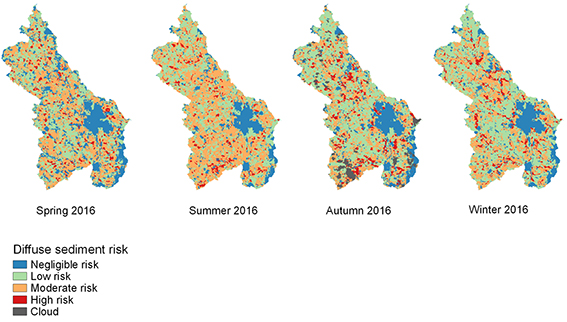This spring and summer has seen extremes of weather persisting across much of the UK, with torrential rain followed by prolonged dry periods and unusually high temperatures. So it is a poignant time to stop and think about our future water management approaches. In this article we consider what these challenges mean for the water sector and show how Ricardo is supporting water companies to identify and demonstrate the effectiveness of big data catchment management solutions.
The challenge
Too little or too much water will always have a significant impact on the farming community, energy production, land owners, water companies (and their consumers), wider business needs and the environment. Defra’s 25 year plan(1) aims to ‘leave our environment in a better state than we found it’ with ambitions to ensure clean and plentiful water, thriving plants and wildlife and a reduction in hazards associated with floods and droughts. Meanwhile, Ofwat’s PR19(2) is geared to incentivising innovative approaches that provide sufficient, affordable clean water under growing population and climate change scenarios.
Fifty five percent of the UK’s rivers were deemed to be in a less than good status for phosphorus in 2016(3), but of course it is not just phosphorus that affects the quality of the environment. If you add waste water pollution from industry and road runoff untangling pollution cause and effect and identifying the best solutions and where to apply them within a catchment becomes complex.
Supplies of clean water are further pressurised by climatic-induced hydrological uncertainty and associated flood risk and conversely pipe leakage (estimated as 22% of all water used in 2016/2017(4)) which can exacerbate risks associated with drought. In this context, innovative catchment approaches that combine waste and clean water to tackle increasing water resource pressures are becoming a priority.
Moving from tried and tested end of pipe solutions: the evidence gap
With such challenges, and strict guidance such as the European Drinking Water Directive stating limits of 0.1µg/l for each pesticide, there is a need to deliver sustainable, cost-effective approaches to tackle environmental pressures and provide benefits to people and wildlife.
Embracing more innovative holistic water management alternatives and avoiding traditional high-cost engineered solutions requires water companies to have confidence that they can demonstrate collective financial, social and environmental benefits, risk reduction accrued and long-term sustainability. A strong appreciation of stakeholder aspirations is a good starting point when combined with a sound understanding of catchment risks related to local climate, population and land-use changes. This is when big data can be used to help support these critical decisions.
Using and managing big data
Future risk management comes down to having information for the right place and time scale. Both baseline and future information must be robust enough to answer resilience questions. Traditionally, collecting and analysing this data has been time consuming and costly, and when spread over many years, the whole process can become prohibitively expensive.
Taking a digital systems approach to data collection via remote monitoring and control (micro-drones, autonomous vehicles and environmental sensors) is now seen as part of the solution. Whether it be 15-minute autonomous water quality and water level evidence or monthly changes in land cover from imagery, the thirst for real time data is insatiable. But with this comes a requirement to use new approaches, such as machine learning and artificial intelligence, to process data more quickly and efficiently to provide scenarios and support decision making.
Ricardo has developed a cost-effective method to support open discussions with stakeholders (from residential and industrial water customers to regulatory organisations) ultimately to agree which catchment solutions can provide the greatest combined water resource, environmental and societal effects. Embedding quick to run algorithms into a model that uses open source GPS and satellite imagery, alongside other data, can identify zones of influence and enable an end-user to quickly compare the impact of different environmental factors. The advantage of this approach is that the methodology can be easily adapted to a range of environmental questions (e.g. the risk to peatlands under different climatic conditions or the identification of urban infrastructure suitable to reduce flood risk) and can accommodate a range of data types and sizes.
Ricardo recognises the need to make the most of all the environmental data available to solve complex problems. The graphical interpretation presented below is just one example of many solutions that we have developed that use big data to support risk analysis and identify environmental hotspots.
The case for change?
In a constantly changing world the need to implement cost-effective innovative catchment management to ensure future water resource and environmental resilience is no longer a ‘nice to have’. As water companies prepare to move away from vastly centralised assets to more joined-up solutions that still meet the needs of customers this approach will become more the norm. But understanding catchment complexity relies on innovative integration of data to tease out innovative solutions to problems that are cost effective and resilient for rural and cityscapes alike. Big data is here to stay but how you use and manage it will determine its success in supporting decision making.
ee.ricardo.com/water
References
1. HM Government. A Green Future: Our 25 Year Plan to Improve the Environment Open Government Licence version 3.0, 2018
2. Delivering Water 2020: Our Final Methodology for the 2019 price review, Ofwat, December 2017
3. The state of the environment: water quality, Environment Agency, February 2018
4. Water companies losing vast amounts through leakage, as drought fears rise. The Guardian, D Carrington, Environment Editor, 11 May 2017






